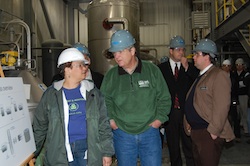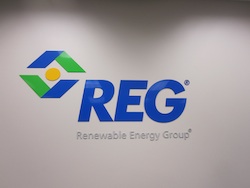 There are few people who know the biodiesel industry like Brad Albin, vice president of manufacturing for REG. Albin has been in the industry for more than 20 years – before many of us even knew what biodiesel was. Albin was on hand for the briefing and tour of REG’s Newton, Iowa biodiesel plant by USDA Ag Secretary Tom Vilsack and EPA Administrator Lisa Jackson. Vilsack is the former governor of Iowa and in this role, played an important part in growing Iowa’s renewable fuel industry. However, Jackson is much newer to the industry and she was very animated and engaged throughout the events.
There are few people who know the biodiesel industry like Brad Albin, vice president of manufacturing for REG. Albin has been in the industry for more than 20 years – before many of us even knew what biodiesel was. Albin was on hand for the briefing and tour of REG’s Newton, Iowa biodiesel plant by USDA Ag Secretary Tom Vilsack and EPA Administrator Lisa Jackson. Vilsack is the former governor of Iowa and in this role, played an important part in growing Iowa’s renewable fuel industry. However, Jackson is much newer to the industry and she was very animated and engaged throughout the events.
Since Albin has such a colorful history with biodiesel, I first asked him how the industry has evolved over the past 20 plus years.
“Over the last ten years I have seen the industry go from a few different feedstocks such as soybean oil to using 30 to 40 different feedstocks all the way from the used cooking oil that comes from McDonalds or Burger King all the way to inedible corn oil that is now being produced on the back-end of an ethanol plant,” said Albin. “So the amount of feedstocks we use are reducing the price, the quality is outstanding and the industry is going forward at a great pace.”
Listen to my full interview with Brad Albin: The Changing Face of Biodiesel
 Albin said that the future of the biodiesel industry is taking lower cost feedstocks that are inedible and changing those into biodiesel versus using higher cost refined oils. REG believes they have conducted the largest feedstock study ever. The study looked at emerging feedstocks such as camelina oil, to future feedstocks such as jatropha and algae. He is excited for the potential of algae, which REG was able to convert into biodiesel in their feedstock study. He explained where you get a certain amount of oil per acre from soybean or canola, there is the potential to get 10,000 times that much oil per acre with algae.
Albin said that the future of the biodiesel industry is taking lower cost feedstocks that are inedible and changing those into biodiesel versus using higher cost refined oils. REG believes they have conducted the largest feedstock study ever. The study looked at emerging feedstocks such as camelina oil, to future feedstocks such as jatropha and algae. He is excited for the potential of algae, which REG was able to convert into biodiesel in their feedstock study. He explained where you get a certain amount of oil per acre from soybean or canola, there is the potential to get 10,000 times that much oil per acre with algae.
Albin said that you could see EPA Administrator Lisa Jackson’s eyes opening up quite a bit she saw the possibilities for feedstocks to be converted to biodiesel. This is key because confidence in the biodiesel industry is essential as the EPA continues to raise the fuel goals each year to meet the Renewable Fuels Standard (RFS2).
I asked Albin what the next step is for REG and he said it is to continue the path. “To push the envelop. Use new feedstocks. We’re building plants and upgrading plants all across the United States. It’s just continuing that effort. We need the support from everyone because its all about energy security. We’ve got these great renewable products that are a huge competitive benefit for the United States of America and I think if everyone gets on the same bandwagon it’s just a great thing.”
Click here to see photos from the USDA/EPA REG biodiesel plant briefing and tour.

